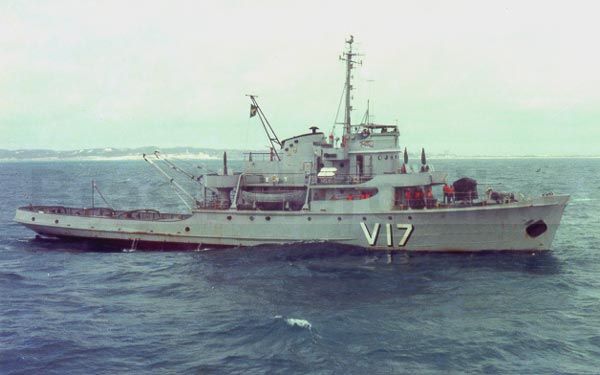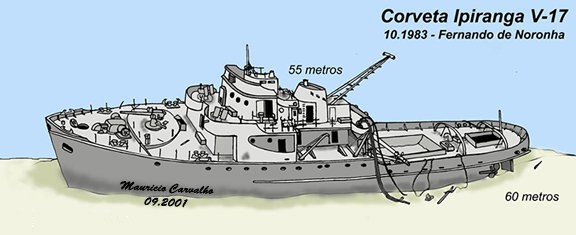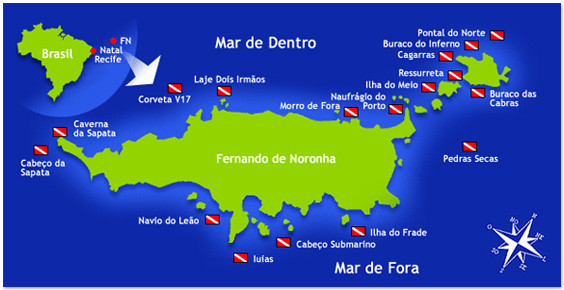Corvette Ipiranga (V-17): One of Brazil’s most iconic shipwrecks
One of Brazil’s most famous shipwrecks, the Brazilian Navy’s Corvette V-17 – Ipiranga, lies at a depth of around 62 metres in the waters off Ponta da Sapata in the Fernando de Noronha archipelago.
Very well preserved by the island’s dive operators, the Ipiranga has practically all its structures intact. Inside are various objects and belongings abandoned by the crew during the shipwreck.

Video about the Ipiranga Corvette

History of the Corvette Ipiranga
The Corveta Ipiranga was the fourth ship of the Brazilian Navy to bear this name, in honour of the Riacho do Ipiranga, the symbolic site of the Proclamation of Brazilian Independence.
Built in the Netherlands, her keel was laid on 17 October 1953, she was launched on 26 June 1954 and incorporated into the Brazilian Navy on 6 January 1955.
Designed to be multi-functional, the corvette was based on an ocean-going tugboat model and could serve as a patrol ship, tugboat, logistical support ship, firefighting ship and minesweeper.

Technical data of the Ipiranga corvette (V-17)
- Class: Imperial Seaman (Dutch design ladies)
- Displacement: Light: 650 tonnes | Loaded: 900 tonnes
- Dimensions: Length: 63.2 metres | Width: 9.4 metres | Draft: 3.5 metres
- Propulsion: 2 Stork-Werkspoor diesel engines (3,000 hp) | 2 shafts with fixed pitch propellers
- Maximum speed: 15 knots (approx. 28 km/h)
- Autonomy: 5,000 nautical miles at 12 knots
- Crew: 70 to 90 men
- Armament: 1 Bofors 40 mm gun | 2 Oerlikon 20 mm machine guns | Naval mine laying capability
- Equipment: Navigational radar, naval communication systems, winches, cranes and fire fighting equipment
The accident and shipwreck
On 3 October 1983, during a coastal patrol mission in northeastern Brazil, the Corveta Ipiranga approached Fernando de Noronha to carry out logistical support duties for the island’s garrison.
On a calm morning, the ship collided with the rock formation known as Cabeça da Sapata, which rises from a depth of more than 70 metres to less than 2 metres at low tide.

Although it is a known hazard to navigation and is suspected of causing the sinking of the Américo Vespúcio’s ship, there are no nautical signals at the site.
After the collision, the Ipiranga remained afloat for around 8 hours, allowing boats from the island to rescue the crew and remove important materials. The Morro do Pico could be seen from the corvette’s last position before it sank.
The crew was rescued by local fishermen and there were no fatalities.
The Navy investigation concluded that there was no one to blame for the accident.
Final destination: A diver’s paradise
Today, the wreck of the Corveta Ipiranga remains in a navigable position at a depth of around 62 metres, making it one of Brazil’s most emblematic dive sites.
The structure is virtually intact, with passages, corridors and compartments still accessible – but requiring technical diving experience due to the depth and local currents.
Publicações Relacionadas
Surfing in Fernando de Noronha: Everything You Need to Know
Ilhabela is the hottest spot on the north coast of São Paulo State
Trindade and Martim Vaz: Discovering the Archipelago
Diving in the Fernando de Noronha Archipelago
How to get there, when to go and what to do in Fernando de Noronha?
Jararaca-ilhoa: Endemic Species of Queimada Grande
The Marajó Archipelago
Fernando de Noronha Beaches: A Complete Guide
Itamaracá Island: Your Ultimate Guide to Tropical Bliss in Brazil
Spinner Dolphins in Fernando de Noronha: A Guide
Alcatrazes Archipelago: Secrets of Evolution Revealed
History of Itaparica Island in the Baía de Todos os Santos
Brazil has oceanic and continental islands
São Pedro and São Paulo Archipelago
Anchieta Island: History, Beaches, and Nature
Experience the Tropical Paradise of Ilha Grande in Rio de Janeiro
The island of Santa Catarina is part of the municipality of Florianópolis
Ponta do Boi Lighthouse in Ilhabela
This post is also on:
![]() Português
Português ![]() English
English ![]() Deutsch
Deutsch ![]() Español
Español ![]() Français
Français




















